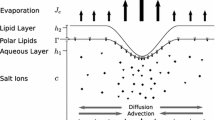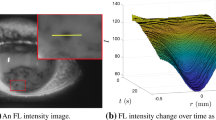Abstract
This paper investigates the effect of surfactants during tear film deposition and subsequent thinning. The surfactants occur naturally on the surface of the tear film in the form of a lipid layer. A lubrication model is developed that describes lipid spreading and film height evolution. It is shown that lipids may play an important role in drawing the tear film up the cornea during the opening phase of the blink. Further, nonuniform distributions of lipids may lead to a rapid thinning of the tear film behind the advancing lipid front (shock). Experiments using a fluorescein dye technique and using a tearscope were undertaken in order to visualise the motion of the lipid layer and any associated shocks immediately after a blink. It is found that the lipid layer continues to spread upwards on the cornea after the opening phase of the blink, in agreement with the model. Using the experimental data, lipid particles were tracked in order to determine the surface velocity and these results are compared to the model predictions.
Similar content being viewed by others
References
Berger, R.E., Corrsin, S., 1974. A surface tension gradient mechanism for driving the pre-corneal tear film after a blink. J. Biomech. 7, 225–238.
Braun, R.J., Fitt, A.D., 2003. Modelling drainage of the precorneal tear film after a blink. Math. Med. Biol. 20, 1–28.
Bron, A.J., Tiffany, J.M., Gouveia, S.M., Yokoi, N., Voon, L.W., 2004. Functional aspects of the tear film lipid layer. Exp. Eye Res. 78, 347–360.
Brown, S.I., Dervichian, D.G., 1969. Hydrodynamics of blinking. In vitro study of the interaction of the superficial oily layer and the tears. Arch. Ophthalmol. 82, 541–547.
Craig, J.P., Tomlinson, A., 1997. Importance of the lipid layer in human tear film stability and evaporation. Optom. Vis. Sci. 74, 8–13.
Doane, M.G., 1980. Interactions of eyelids and tears in corneal wetting and dynamics of the normal human eyeblink. Am. J. Ophthalmol. 89, 507–516.
Doane, M.G., 1981. Blinking and the mechanics of the lacrimal drainage system. Ophthalmology 88, 844–851.
Doane, M.G., 1994. Abnormalities of the structure of the superficial lipid layer on the in vivo dry-eye tear film. Adv. Exp. Med. Biol. 350, 489–493 (also In: Lacrimal Gland, Tear Film and Dry Eye Syndromes).
Edwards, D.A., Brenner, H., Wasan, D.T., 1991. Interfacial Transport Processes and Rheology. Butterworth-Heinemann, Boston, MA.
Iskander, D. R., Collins, M. J., Davis, B., 2005. Evaluating tear film stability in the human eye with high speed videokeratoscopy. IEEE Trans. Bio.Med. Eng. 52 (11), 1939–1949.
Iwata, S., Lemp, M.A., Holly, F.J., Dohlman, C.H., 1969. Evaporation rate of water from the precorneal tear film and cornea in the rabbit. Invest. Ophthalmol. 8, 613–619.
Jensen, O.E., Grotberg, J.B., 1992. Insoluable surfactant spreading on a thin viscous film: Shock evolution and rupture. J. Fluid Mech. 240, 259–288.
Jones, M.B., Please, C.P., McElwain, D.L.S., Fulford, G.R., Roberts, A.P., Collins, M.J., 2005. Dynamics of tear film deposition and draining. Math. Med. Biol. 22, 265–288.
Korb, D.R., Baron, D.F., Herman, J.P., Finnemore, V.M., Exford, J.M., Hermosa, J.L., Leahy, C.D., Glonek, T., Greiner, J.V., 1994. Tear film lipid layer thickness as a function of blinking. Cornea 13, 354–359.
McCulley, J.P., Shine, W., 1997. A compositional based model for the tear film lipid layer. Trans. Am. Ophth. Soc. 95, 79–93.
McCulley, J.P., Shine, W.E., 2004. The lipid layer of tears: Dependent on meibomian gland function. Exp. Eye Res. 78, 361–365.
McDonald, J.E., 1969. Surface phenomena of the tear film. Am. J. Ophthalmol. 67(1), 56–64.
Miller, D., 1969. Measurement of the surface tension of tears. Arch. Ophthalmol. 82, 368–371.
Mishima, S., Gasset, A., Klyce, S.D., Baum, J.L., 1966. Determination of tear volume and tear flow. Invest. Ophthalmol. 5(3), 264–275.
Mishima, S., Maurice, D. M., 1961. The oily layer of the tear film and evaporation from the corneal surface. Exp. Eye Res. 1, 39–45.
Nagyova, B., Tiffany, J. M., 1999. Components responsible for the surface tension of human tears. Curr. Eye Res. 19, 4–11.
Nemeth, J., Erdelyi, B., Csakany, B., Gaspar, P., Soumelidis, A., Kahlesz, F., Lang, Z., 2002. High-speed videotopographic measurement of tear film build-up time. Invest. ophthalmol. Vis. Sci. 43, 1783–1790.
Owens, H., Phillips, J., 2001. Spreading of the tears after a blink velocity and stabilization time in healthy eyes. Cornea 20(5), 484–487.
Probstein, R.F., 1994. Physicochemical Hydrodynamics. Wiley, New York.
Rolando, M., Refojo, M. F., 1983. Tear evaporimeter for measuring water evaporation rate from the tear film under controlled conditions in humans. Exp. Eye Res. 36, 25–33.
Sakata, E.K., Berg, J.C., 1969. Surface diffusion in monolayers. IEC Fundament. 8, 570–575.
Schwartz, L.W., Weidner, D. E., 1995. An analysis of the effect of surfactant on the leveling behaviour of a thin liquid coating layer. Langmuir 11, 3690–3693.
Sharma, A., Ruckenstein, E., 1985. Mechanism of tear film rupture and its implications for contact lens tolerance. Am. J. Optom. Physiol. Opt. 62(4), 246–253.
Wilson, S.D.R., 1982. The drag-out problem in fluid coating heory. J. Eng. Math. 16, 209–221.
Zhang, Y.L., Matar, O.K., Craster, R.V., 2003. Analysis of tear film rupture: Effect of non-newtonian rheology. J. Colloid Interf. Sci. 262, 130–148.
Zhu, M., Collins, M.J., Iskander, D.R., 2006. Dynamics of tear film topography. Eye In press.
Author information
Authors and Affiliations
Corresponding author
Rights and permissions
About this article
Cite this article
Jones, M.B., McElwain, D.L.S., Fulford, G.R. et al. The Effect of the Lipid Layer on Tear Film Behaviour. Bull. Math. Biol. 68, 1355–1381 (2006). https://doi.org/10.1007/s11538-006-9105-9
Received:
Accepted:
Published:
Issue Date:
DOI: https://doi.org/10.1007/s11538-006-9105-9




